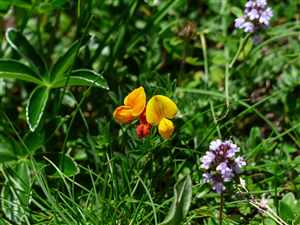Fenugreek (Tigonella foenum-graecum)
Main Facts about Fenugreek

Using Fenugreek
Fenugreek has various medicinal applications. It is famously used as a breast enlarger even though . It also helps balance blood sugar levels and has been used for controlling high blood sugar in people with diabetes. There are some data from clinical studies that show cholesterol lowering effect of the plant. Studies investigating the use of fenugreek in diabetes and cholesterol lowering have used 5 g/day of seeds or 1 g of a hydroalcoholic extract. Fenugreek is a uterine stimulant and has been used traditionally to induce labor. It reduces discomfort during periods and has been traditionally used to increase lactation in breastfeeding mothers. In addition, eating Fenugreek helps with menopausal symptoms (mood swings, depression, cramps). The seeds are very nourishing and are given to convalescents and to encourage weight gain. Fenugreek seeds freshen bad breath. The seeds can be ground into a powder and used externally as a poultice for abscesses, boils, ulcers, and burns. Fenugreek seed contains mucilage, which may be responsible for Fenugreek tea's value as a laxative and as an aid in curing ulcers and other stomach problems. Fenugreek's high fiber content makes it helpful in treating constipation and diarrhea, while also relieving minor indigestion. Taking Fenugreek 30 min before meal twice a day may reduce heartburn. Fenugreek tea soothes sore throat and helps reducing fever. Fenugreek is a natural source of protein, it reduces hair fall and promotes hair growth. It is also a powerful ingredient in skin products.Fenugreek is a remedy for: Cold and flu, Constipation
Caution!
Some people reported gastrointestinal problems (flatulence, diarrhea) or nausea. Do not take if pregnant. Use with caution if you have low blood sugar or take diabetes medication.Cooking with Fenugreek
Fenugreek is used as an herb (dried or fresh leaves), spice (seeds), and vegetable (fresh leaves, sprouts, and microgreens). When ground into a powder, the seed is a principal ingredient of curries and mango chutney, it is also used in pickles and spice mixes. Fenugreek combines the taste of celery and maple. It enhances the taste of meats, poultry, marinated vegetables, and curry blends. The seeds are used whole or ground. The roasted seed can be used as a coffee substitute. A soothing tea is made from the leaves and the seed. To make Fenugreek tea, steep 1 oz of seeds in 1 pint (16 oz) of boiling water. You can add a little honey or peppermint extract to the tea to improve its odor and taste.How to grow Fenugreek
Plant seeds thickly in a rich soil that has been deeply plowed. It cannot grow in the shade. Seeds can be sown when the soil temperature reaches 55F. In cold wet soil, root rot may occur. It is in flower from June to August, and the seeds ripen from August to September. Harvest the pods when ripe, but before they begin to shatter.| Fennel |
Feverfew
|